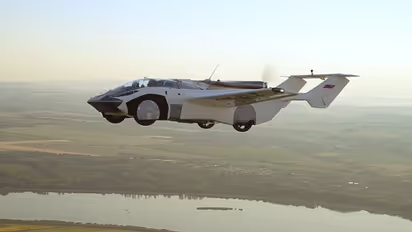Flying car now a reality, AirCar completes first ever inter-city flight

Synopsis
AirCar completed its first inter-city flight -- a 35-minute flight from the international airport in Nitra to the international airport in Bratislava in southwestern Slovakia.
AirCar, a flying car that can change from vehicle mode to flying mode in a short time, inched closer to production this week when it fulfilled a key development milestone on June 28.
AirCar completed its first inter-city flight -- a 35-minute flight from the international airport in Nitra to the international airport in Bratislava in southwestern Slovakia.
After landing, the aircraft transformed into a sports car at a click of a button. The transformation happened in under three minutes.
AirCar's inventor, Professor Stefan Klein, and co-founder Anton Zajac later drove the car into downtown Bratislava.
Professor Klein said that inter-city flight marked the beginning of the new age of dual transportation vehicles.
He further said that the latest flight had opened a new form of transportation and returned the freedom originally attributed to cars back to the individual.
Anton Zajac, the co-founder of Klein Vision, said that their invention is not just a proof of concept any longer.
"AirCar has turned science fiction into a reality," he said.
Dr Branko Sarh, a Senior Technical Fellow at Boeing Co, said that the transition from a road vehicle into an air vehicle and vice versa with wings and tail is the result of pioneering enthusiasm and an outcome of excellent engineering and professional knowledge.
The AirCar Prototype 1 has a fixed-propeller and a ballistic parachute and is equipped with a 160HP BMW engine.
The AirCar has completed over 40 flight hours, including steep 45 degree turns and stability and manoeuvrability tests, under the supervision of the Civil Aviation Authority.
AirCar Prototype 1 has flown at 8200 ft and reached a maximum cruising speed of 190km/h (103kt).
AirCar Prototype 2, the pre-production model, will be equipped with a 300HP engine and receive the EASA CS-23 aircraft certification with an M1 road permit.
With its variable pitch propeller, Prototype 2 is expected to have a cruise speed of 300km/h (162kt) and a range of 1000km (621mi).
Find the latest Technology News covering Smartphone Updates, AI (Artificial Intelligence) breakthroughs, and innovations in space exploration. Stay updated on gadgets, apps, and digital trends with expert reviews, product comparisons, and tech insights. Download the Asianet News Official App from the Android Play Store and iPhone App Store for everything shaping the future of technology.